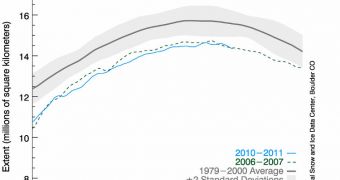A group of scientists in the United States says that the Arctic has reached its maximum extent of ice cover for this year on March 7. This means that, in the coming months, the cover will begin to diminish until next winter.
The first week of March basically signaled the beginning of the Arctic melt season, according to experts at the US National Snow and Ice Data Center (NSIDC). Their analysis of the event yields some worrying conclusions.
Statistics show that 2011's maximum ice extent tied to the lowest on record. This means that the ice sheets are not recuperating, as some have suggested, but rather diminishing to very low levels.
The US organization, which is responsible for keeping an eye on ice extents at the North Pole, says that it will release an in-depth analysis on the situation in the second week of April. The study should provide additional insight into the factors that stemmed snow cover growth this year.
The maximum ice extent the team recorded for this year was 471,000 square miles (1.2 million square kilometers) lower than the 1979 to 2000 average. On March 7, ices covered about 14.64 million square kilometers (5.65 million square miles) in the Arctic.
NSIDC reports that this value is equal within 0.1 percent to that recorded in 2006, the year with the lowest maximum extent ever recorded since satellite surveys began. This happened about four decades ago, experts say.
“As of March 22, ice extent has declined for five straight days. However there is still a chance that the ice extent could expand again,” a statement released by the Center announces.
“Sea ice extent in February and March tends to be quite variable, because ice near the edge is thin and often quite dispersed,” the NSIDC team reveals. The organization is releasing new reports on the state of Arctic ices every month.
“The thin ice is highly sensitive to weather, moving or melting quickly in response to changing winds and temperatures, and it often oscillates near the maximum extent for several days or weeks, as it has done this year,” the experts go on to say.
The factors that affect the growth of the Arctic sheets are multiple. They include global warming, climate change, warming waters, changing currents and several feedback loops that fuel ice melt.
According to scientists, there is a distinct possibility that the North Pole will soon become ice-free during the summer months. Analysts suggest that this could happen between 30 and 50 years from now.

 14 DAY TRIAL //
14 DAY TRIAL //